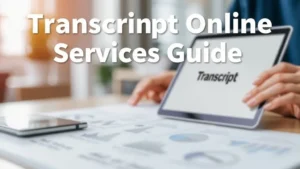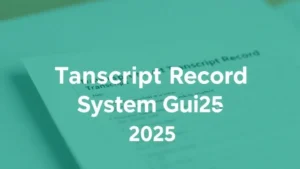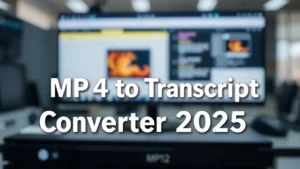Transcript Meaning: Complete Guide 2025
You’ve seen “transcript meaning” pop up when applying to schools, ordering captions, or checking tax statements. And you’re not alone. By 2025, the global transcription market is projected to reach $37.6 billion—proof this topic matters (Grand View Research). You want clarity. You want details. You want to know how transcripts work across education, media, business, and law.
In this guide, you’ll learn what transcripts are, explore key types, discover how to create or obtain them, and pick up best practices for accuracy and accessibility. Let’s dive in.
Here’s what’s coming:
- Definition & importance
- Common transcript types
- Creation & request processes
- Formatting, cost, and tools
- Future trends
Ready to demystify “transcript meaning”?
Table of Contents
- What Does Transcript Meaning Really Tell Us?
- Types of Transcript Meaning: Academic, Media, Legal, and More
- How to Create and Obtain Transcripts in 2025
- Best Practices: Formatting, Accuracy, and Accessibility
- Future Trends and Advanced Tips for Experts
- Frequently Asked Questions
- 1. What is the difference between a transcript and a report?
- 2. How long does it take to get an IRS transcript?
- 3. Can I edit an official academic transcript?
- 4. Are AI transcripts accurate enough for legal use?
- 5. What’s the best format for video captions?
- Conclusion
What Does Transcript Meaning Really Tell Us?
You might be wondering: what exactly is a transcript, and why does its meaning vary so much? In other words, how you use it depends on the context.
At its core, a transcript is a written record of spoken words or academic performance. That simple concept becomes powerful when you need proof of grades, captions for your video, or a verbatim record of an interview.
Consider a student applying for grad school. Their academic transcript—detailed AI Transcript Tools: 10 Time-Saving Strategies for Researchers—shows courses, grades, credits, and institution data. Without it, admission stalls.
“Accurate transcripts are essential for web accessibility and legal compliance.” — W3C Accessibility Guidelines
Actionable takeaway: Pin down the purpose first. Are you documenting grades, capturing dialogue, or fulfilling a legal requirement? That determines the format and source you need.
Types of Transcript Meaning: Academic, Media, Legal, and More
Why does one word cover so many domains? Let me explain.
- Academic Transcripts – Official records of your courses, grades, and credits.
- Interview Transcripts – Word-for-word records of conversations (YouTube to Transcript Converter – 100% Free).
- Media Transcripts – Captions or subtitles for videos and podcasts.
- IRS Transcripts – Tax return, account summaries, wage & income data (IRS).
- Legal Depositions – Verbatim records used in court proceedings.
Each serves a unique audience. A podcaster needs media captions for SEO and accessibility, while a business owner may request an IRS transcript to verify tax filings.
Example: Jane used her tax account transcript to quickly resolve a missing deduction. Her accountant praised her foresight.
Actionable takeaway: List your transcript needs by context—education, media, tax, or law—then match the right type to your goal.
How to Create and Obtain Transcripts in 2025
Ready to get hands-on? Here’s the bottom line: you can DIY with AI or outsource to professionals.
Follow these steps:
- Identify your transcript type and format requirements.
- Choose a service: human ($1.25–$4.50/min) or AI ($0.10–$0.25/min). Rev charges $1.50/min for humans and $0.25/min for automated scripts.
- Upload your audio/video or request from an institution (schools, IRS, courts).
- Proofread and correct speaker labels, time-stamps, and typos.
- Format per your audience: APA style for academia, SRT for video, or official IRS letterhead.
Case Study: A startup recorded 10 hours of customer interviews and cut costs by 80% using AI, then contracted a 2-hour human review.
Actionable takeaway: Budget both time and money. Pick a hybrid approach for speed and precision.
Best Practices: Formatting, Accuracy, and Accessibility
Sloppy transcripts? No thanks. Formatting is key.
Follow these guidelines:
- Use clear speaker labels (Speaker 1, Speaker 2).
- Include time-codes every 30 seconds or at speaker changes.
- Proofread with a second pair of eyes.
- Ensure compliance with ADA and WCAG standards.
“Transcripts must be both accurate and accessible to meet legal requirements.” — U.S. Department of Education
Example: A nonprofit added transcripts to its webinars, boosting engagement by 25% and improving SEO rankings.
Actionable takeaway: Adopt a style guide (e.g., APA or broadcast standards) and stick to it for consistency.
Future Trends and Advanced Tips for Experts
The transcript world is evolving fast. Real-time AI, voice-search optimization, and integrated analytics are on the rise.
Here’s what to watch:
- AI accuracy hitting human parity by 2026.
- Real-time captions in augmented-reality meetings.
- Automated sentiment tagging for market research.
- Blockchain-verified transcripts for legal security.
Example: Otter.ai now integrates with Zoom, auto-generating meeting minutes and action items—saving teams hours each week.
Actionable takeaway: Test one new tool this quarter. Track time saved and error rates to measure ROI.
Frequently Asked Questions
1. What is the difference between a transcript and a report?
A transcript is a verbatim record of speech or academic performance. A report summarizes data or events without word-for-word detail.
2. How long does it take to get an IRS transcript?
Online requests deliver instantly. Mail requests take 5–10 business days.
3. Can I edit an official academic transcript?
No. Only issuing institutions can modify official transcripts. You may request an amended version if errors occur.
4. Are AI transcripts accurate enough for legal use?
Not yet. Legal and court transcripts still require certified human stenographers for admissibility.
5. What’s the best format for video captions?
SRT is widely supported. WebVTT offers richer metadata for advanced players.
Conclusion
Transcript meaning spans education, media, business, and law—but the goal remains the same: accurate, accessible records. You’ve explored definitions, types, creation methods, best practices, costs, and future trends. Now it’s your move.
Next steps:
- Pinpoint your transcript’s purpose and type.
- Choose the right tool: human, AI, or hybrid.
- Implement a consistent style guide for formatting and accessibility.
With these actions, you’ll master transcript meaning and leverage transcripts for maximum impact in 2025 and beyond. Happy transcribing!





